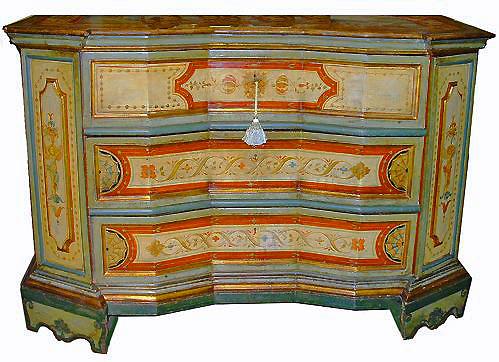A Grand Palazzo
The grand palazzi faced directly onto the larger canals, and it was here that the finest furnishings, including fitted furniture, were enjoyed by Venice's wealthiest citizens. Huge anti-chambers measured around 36m (120ft), and special furniture was created for these rooms. A long bergere with an upholstered back, the pozzetto, was designed to be placed against the walls, as was the exaggerated divani da portego, a long settee.
The family bedchambers and associated rooms were furnished in luxurious velvet and damask, often fringed or laced with gold. The floors were laid with marble or scagliola, and the frescoes on the skirting boards and ceilings added more colour.
At times, the overall effect could be overpowering, and the furniture and decoration competed for prominence.
Bedchamber from the Sagredo Palace, Venice. c.1718
The furnishings relate to the overall architectural theme. The sculptural quality of the ceiling is reflected in the ornately carved headboard.
Furniture Styles
Much Venetian handmade furniture was brightly painted or decorated with lacquer, silver, or gilt, and ornately carved. Venetian design was the embodiment of the effusive Rococo style, which remained fashionable in Venice after its popularity had waned elsewhere.
Although the furniture retained the sculptural qualities of the Baroque, the carving was lighter and more delicate. Scrolls, serpentine outlines, and bombe shapes were common. Cabriole legs were often decorated with Rococo carving.
New types of furniture, now reproduction furniture, included girandole mirrors, and gueridon tables that had a candlestand base supporting a marble top. Even large pier tables had carved and pierced frames that were gilded or painted in the Rococo style. In addition to pier mirrors or glasses placed over pier tables, other mirrors were introduced that often contained coloured panels of glass interspersed with the mirror glass.
Chests of drawers ranging from the French commode to smaller pieces such as the cassettoncino, typically with three serpentine-shaped drawers with square ends. These were often veneered in walnut, and supported on ball or bracket feet.
Pairs of small chests, comodini, painted or veneered in walnut, had a single door, sometimes with a drawer above, and were raised on short, curved or scrolled feet.
Another popular form was a small, bombe-shaped, two-door chest.
Lacquer
Lacquerwork was very popular in Venice, and was used to adorn everything from commodes to armchairs. Chinoiserie designs imitated imported Far Eastern lacquer, but Venetian craftsmen incorporated whimsical floral motifs, often with foliage.
It often took 20 layers of varnish to fully complete the lacquer process. Although the outsides of pieces were effusively decorated, the interiors were often relatively plain. Light colours were popular for lacquer, especially yellow, gold, and blue.
18th Century Venetian Commode
A Pristine 18th Century Venetian Polychrome Concave Block Front Commode Credenza with three long drawers and two secret and canted side doors opening to reveal ten polychromed cubby drawers, embellished with mascaron, strings of pearls and foliate motifs

No comments:
Post a Comment